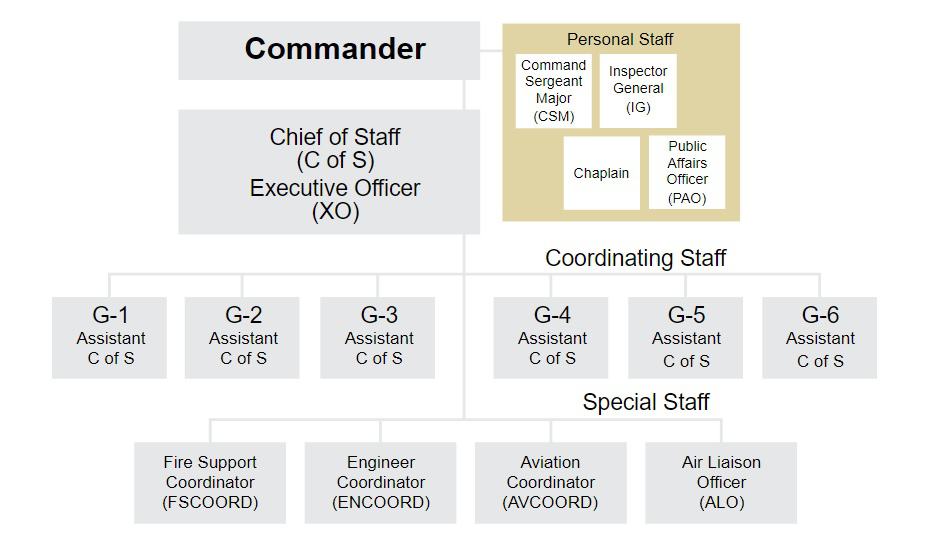
A staff section is a grouping of staff members by their area of expertise. There are three basic types of army staff:
- Coordinating Staff
- Special Staff
- Personal Staff
Foreign requirements determine how commanders organize and adapt their individual staff.
Missions can also determine the size and composition of staff and the command post. Organizing a staff by function or type is an important part of a command and control system.
Army Coordinating Staff
Coordinating staffs are the commander’s principal staff assistants who advise, plan, and coordinate actions within their area of expertise.
They are directly accountable to the chief of staff or the executive officer and have a functional responsibility over one or a combination of fields of interest. You know them best as the G staff or the S staff, such as the G1 or the S3.
G staff (General Staff at the division level or higher) or the S staff (Special Staff at the brigade or battalion level):
G Staff/S Staff
- G1/S1: Personnel and Administration
- G2/S2: Intelligence and Security
- G3/S3: Operations and Training
- G4/S4: Logistics and Supply
- G5/S5: Civil Affairs (when assigned)
- G6/S6: Signal/Communications
- G7/S7: Training and Operations (when assigned)
- G8/S8: Financial Management (when assigned)
Army Special Staff
Special staffs help commanders and other staff members perform their functional responsibilities and are organized according to professional or technical responsibilities and expertise.
The commander delegates planning and supervisory authority over each special staff section to a coordinating staff officer or, sometimes, directly to the chief of staff, depending on the mission and the requirement for planning.
Special staff includes personnel like:
- Air missile defense officer,
- Early liaison officer
- Provost Marshal
Army Personnel Staff
Personnel staff works under immediate control and has direct access to the commander.
The commander gives guidance on whether a personal staff officer coordinates with the chief of staff or the XO, or even other staff members.
Some personal staff officers have responsibilities as special staff officers to work with a Coordinating Officer. They do this on a case-by-case basis.
You know them as the:
- Aide-de-camp
- Chaplain
- Inspector General
Staff Officers
Regardless of what type of staff, there is always someone, somewhere, responsible for leading a team.
A principal staff officer, who can be coordinating, special, or personal, is going to lead a staff section.
The terms we use to describe our staff organization are crucial to understanding how the C2 system supports a commander’s decision-making.
If you want to know more details about the type of staff or if you want to see where you and your team fall on the coordinating, special, or personal staff roster, you should check out Chapter 2 of our new FM6-0 Commander Staff Organization and Operations.
Types of Army Staff List
| Staff Type | Description | Responsibility | Examples |
|---|---|---|---|
| Coordinating Staff | These are principal staff assistants who advise, plan & coordinate actions. | They are directly accountable to the chief of staff or the executive officer. | G staff, S staff (G1, S3, etc.) |
| Special Staff | They help commanders, & other staff members perform their functional responsibilities. | They are organized according to professional or technical responsibilities & expertise. | Air missile defense officer, Early liaison officer, Provost Marshal |
| Personal Staff | They work under immediate control & have direct access to the commander. | Some have responsibilities as special staff officers to work with a Coordinating Officer. | Aide-de-camp, Chaplain, Inspector General |
- Empowering Transactions: Navigating Firearms Sales with Proper Documentation - April 8, 2024
- Army PRT – Preparation and Recovery 2024 - March 18, 2024
- Active and Reserve Components 2024 - March 6, 2024
